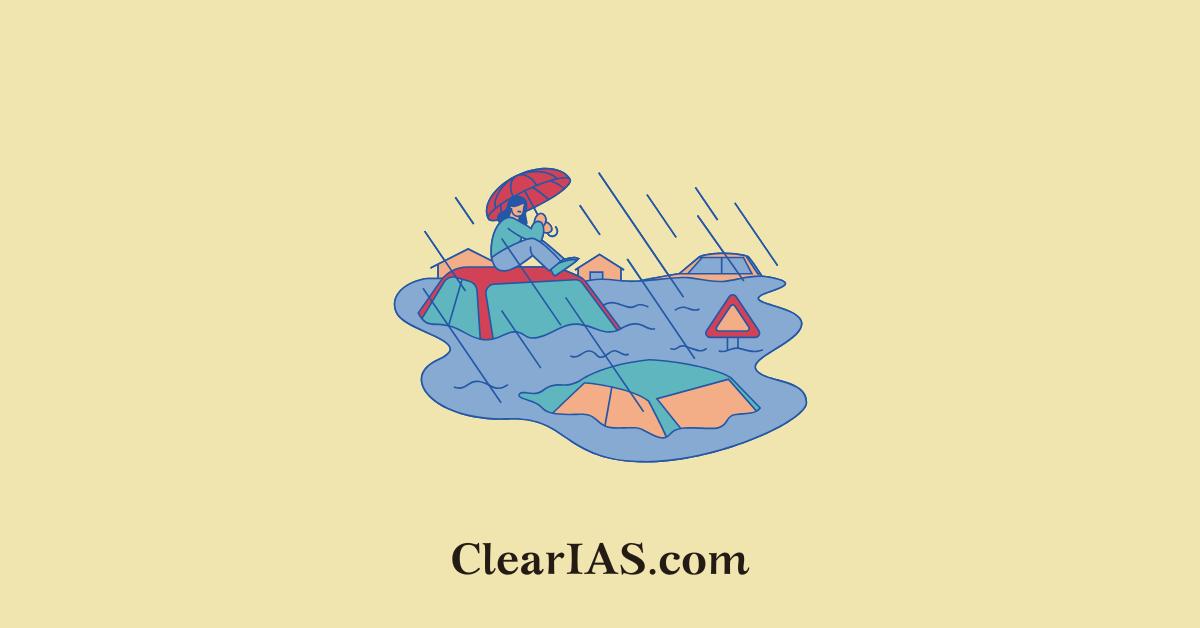
Flash Floods in India are becoming a rising risk in a Changing Climate. Flash floods are no longer random anomalies but a systemic climate-linked disaster. India must transition from a response-oriented to a resilience-focused governance approach, combining technology, local knowledge, and sustainable land-use planning. Read here to learn more.
Flash floods have emerged as one of the most devastating and fast-evolving disasters across India, marked by their sudden onset, short warning time, and severe impact.
Recent tragedies in Himachal Pradesh (July 2025), Wayanad (2024), Ladakh (2024), and Sikkim (2023) underscore the intensifying crisis, which has both climatic and anthropogenic drivers.
What are Flash Floods?
Flash floods are sudden, intense floods that occur within six hours of rainfall or other triggers (e.g., glacial lake outburst, dam failure), characterised by rapid water rise and strong flow velocity.
Trends and Data:
- Flash flood events increased from 132 in 2020 to 184 in 2022 (Jal Shakti Ministry).
- 75% of flash floods result from a combination of extreme rainfall and saturated soil.
- Only 23% of extreme rainfall events result in flash floods within 6 hours.
- More regions previously considered non-prone are becoming vulnerable due to changing climate dynamics.
Findings of the recent IIT Gandhinagar Study
Hotspot Regions Identified:
- Himalayan states (steep terrain, elevation)
- Western coastal regions (high “flashiness”)
- Central India (rapid runoff, changing rainfall patterns)
River Basins Most Affected:
- Brahmaputra, Ganga, and Krishna basins show the highest increase in flash flood events.
- Sub-basin analysis: Southern Himalayan Ganga sub-basins are more vulnerable than central regions.
Climatic Observations:
- Pre-monsoon season: Extreme rainfall doubled (1981–2020).
- Monsoon/post-monsoon/winter: Rise in extreme rainfall by 56%, 40%, and 12.5%, respectively.
- Over 75% of flash floods occur during the monsoon.
Read more about the study here
Key Drivers of Flash Floods in India
Factor |
Impact |
Extreme Rainfall |
Sudden downpours, especially in monsoon and pre-monsoon seasons. |
Soil Saturation |
Pre-wetted soil can’t absorb new rainfall, increasing runoff. |
Topography |
Steep terrain in the Himalayas accelerates water flow. |
Climate Change |
Warmer air holds more moisture, increasing rainfall intensity (7% more per 1°C). |
Land Use Changes |
Deforestation, urbanisation, and encroachment of floodplains worsen flood impacts. |
Infrastructure Gaps |
Poor drainage, lack of embankments, and weak early warning systems. |
Impacts of Flash Floods
- Human Loss: Thousands are displaced or killed annually.
- Infrastructure Damage: Washed-out roads, bridges, and communication lines.
- Livelihood Disruption: Especially for rural populations dependent on agriculture.
- Ecological Degradation: Soil erosion, landslides, siltation of rivers and wetlands.
- Tourism and Economy: Affected in states like Himachal Pradesh and Uttarakhand.
Climate Change and Emerging Risk Zones
- 51% of previously non-prone sub-basins now report increased rainfall.
- 66.5% show higher streamflow, indicating new flash flood zones forming.
- In contrast, some flood-prone areas report reduced “wet hours”, suggesting shifting hydrological patterns.
Need for Region-Specific Adaptation Strategies
- Topography-Based Risk Mapping:
- Use GIS and remote sensing to identify local flood-prone sub-basins.
- Customize early warning systems for response time and terrain.
- Climate-Resilient Infrastructure:
- Elevated roads, reinforced riverbanks, and rainwater harvesting systems.
- Improve drainage in hill towns and urban basins.
- Integrated Flood Management:
- Combine land-use planning, afforestation, and wetland conservation.
- Restrict construction in vulnerable floodplains.
- Community-Based Disaster Risk Reduction (CBDRR):
- Educate and empower locals with early alerts, evacuation drills, and flood kits.
- Involve Panchayats and SHGs in monitoring and preparedness.
- Policy and Institutional Measures:
- Update India’s National Flood Management Policy to account for flash flood dynamics.
- Strengthen inter-agency coordination between IMD, NDMA, Jal Shakti Ministry, and State DMAs.
Conclusion
Flash floods are no longer isolated or unpredictable events; they are the new normal in India’s climate future.
With rising global temperatures and extreme rainfall events on the rise, the need to invest in data-driven planning, early warning systems, and resilient infrastructure is more urgent than ever.
A shift from reactive relief to proactive, region-specific adaptation holds the key to minimizing the human and ecological cost of these sudden disasters.
Frequently Asked Questions (FAQs)
Q. What is the main cause of flash floods?
Ans: Flash floods occur when heavy rainfall exceeds the ability of the ground to absorb it. They also occur when water fills normally dry creeks or streams, or enough water accumulates for streams to overtop their banks, causing rapid rises of water in a short amount of time.
Q. What is the difference between a flood and a flash flood?
Ans: The key difference between a flood and a flash flood lies in their speed of onset and duration. Floods typically develop over hours or days, whereas flash floods occur suddenly, often within minutes or a few hours of heavy rainfall, and are characterized by a rapid rise in water levels.
Related articles:







Leave a Reply